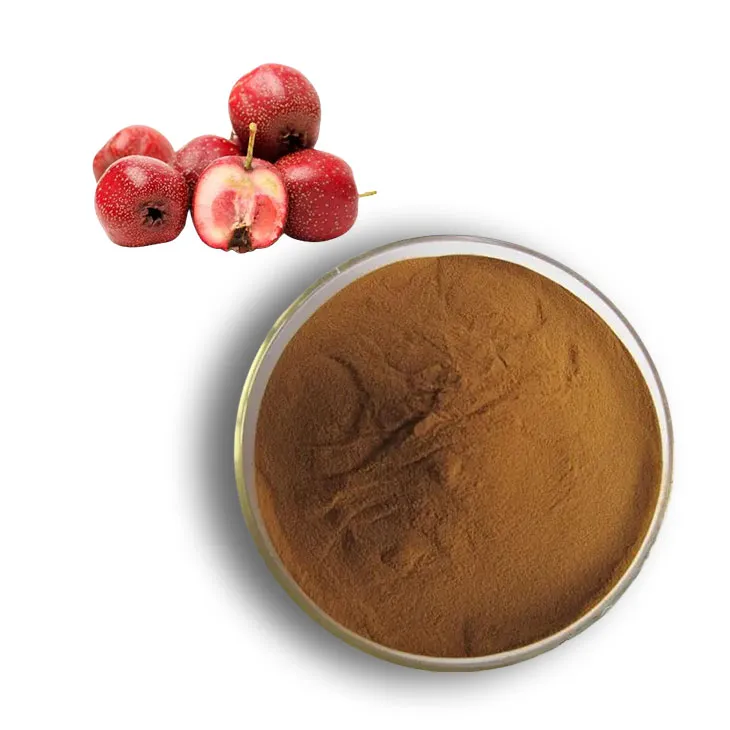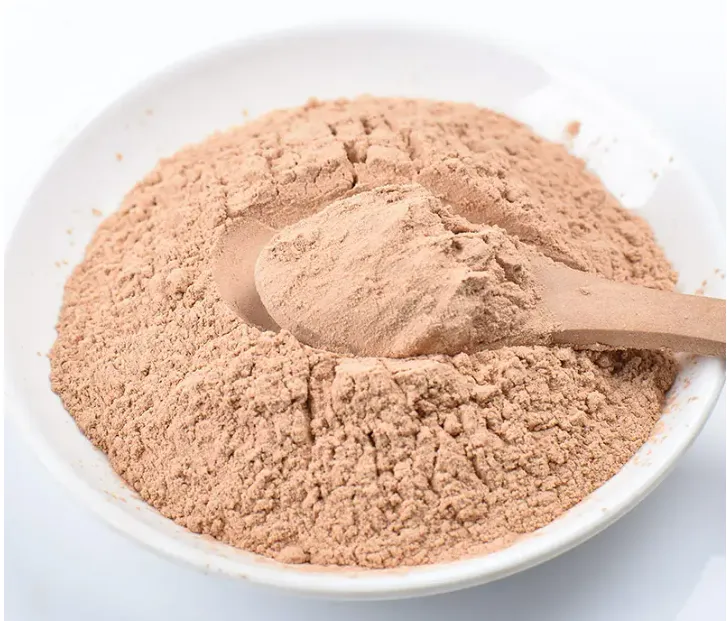- 0086-571-85302990
- sales@greenskybio.com
Components of Hawthorn Extract in Fertilizers and Feeds.
2024-11-29

1. Introduction
Hawthorn, a well - known plant with a long history of use in traditional medicine, has recently drawn attention for its potential applications in fertilizers and feeds. The Hawthorn Extract contains a variety of components that can bring multiple benefits to plants and animals. Understanding these components and their functions is crucial for the development of more effective fertilizers and feeds.

2. Components of Hawthorn Extract in Fertilizers
2.1 Chelating Agents
Hawthorn Extract contains natural compounds that can act as chelating agents for nutrients. Chelating agents are substances that form complexes with metal ions. In fertilizers, these chelating agents can bind to essential nutrients such as iron, zinc, and manganese. This binding process has several important effects.
Firstly, it protects the nutrients from being precipitated or adsorbed in the soil. For example, in alkaline soils, some metal nutrients are prone to form insoluble compounds, which are difficult for plants to absorb. The chelating agents in hawthorn extract can prevent this by keeping the nutrients in a soluble and available form.
Secondly, the chelated nutrients can be more easily transported across the root cell membranes of plants. This is because the complex formed by the chelating agent and the nutrient has a structure that is more compatible with the transport mechanisms in the plant roots. As a result, plants can take up these nutrients more efficiently, leading to better growth and development.
2.2 Antioxidant Compounds
Hawthorn extract also contains antioxidant components that play a significant role in protecting plants from environmental stresses. Antioxidants are substances that can neutralize free radicals, which are highly reactive molecules that can cause damage to cells.
In the context of plants, environmental stresses such as drought, salinity, and pollution can generate a large number of free radicals in plant cells. The antioxidant compounds in hawthorn extract can scavenge these free radicals, thereby reducing oxidative damage to plant cells. For instance, phenolic compounds present in hawthorn extract are known for their antioxidant activity. These phenolic compounds can donate electrons to free radicals, converting them into less reactive species.
Moreover, the antioxidant properties of hawthorn extract can also enhance the plant's resistance to diseases. By maintaining the integrity of plant cells through antioxidant protection, plants are less likely to be invaded by pathogens. This is because healthy cells are better able to mount defense mechanisms against diseases.

3. Components of Hawthorn Extract in Feeds
3.1 Antioxidant Capacity Improvement
In feed applications, hawthorn extract can improve the antioxidant capacity of animals. Animals, like plants, are also exposed to various oxidative stresses. These can come from factors such as diet, environmental pollutants, and normal metabolic processes.
The antioxidant components in hawthorn extract, when consumed by animals, can help to neutralize free radicals in their bodies. This is beneficial for maintaining the health of cells and tissues. For example, in livestock such as cattle and pigs, the addition of hawthorn extract to their feed can reduce oxidative stress in their muscles. This can lead to better meat quality, as oxidative stress can cause lipid peroxidation in muscle cells, which affects the taste, texture, and shelf - life of meat.
Furthermore, in poultry, hawthorn extract can enhance the antioxidant status of eggs. This can be important for consumers, as eggs with higher antioxidant content may have potential health benefits. The antioxidant components in hawthorn extract can be transferred to the eggs, increasing their nutritional value.
3.2 Physiological Function Regulation
Hawthorn extract can also regulate the physiological functions of animals. It contains bioactive compounds that can interact with the animal's endocrine and nervous systems.
For example, in some small animals like rodents, hawthorn extract has been shown to have an impact on their digestive functions. It can stimulate the secretion of digestive enzymes, which helps in the better digestion and absorption of nutrients from food. This can lead to improved growth rates and overall health of the animals.
In addition, hawthorn extract may also play a role in regulating blood lipid levels in animals. In some studies on experimental animals, it has been observed that hawthorn extract can reduce the levels of triglycerides and cholesterol in the blood. This could be beneficial for preventing cardiovascular diseases in animals, especially those that are raised for a long time in captivity and are at risk of developing such diseases.
3.3 Alternative to Synthetic Additives
Hawthorn extract can serve as an alternative to some synthetic additives in animal feeds. In modern animal husbandry, synthetic additives are often used to improve feed efficiency, growth performance, and animal health. However, there are concerns about the potential negative impacts of some synthetic additives, such as antibiotic resistance and residues in animal products.
Hawthorn extract, being a natural product, offers a more sustainable and potentially safer option. It can provide similar functions as some synthetic additives without the associated risks. For example, instead of using synthetic growth promoters, hawthorn extract can be used to enhance the growth performance of animals in a more natural way. It can stimulate the animal's own physiological mechanisms for growth and development, rather than relying on artificial substances.

4. Conclusion
In conclusion, the hawthorn extract contains a rich variety of components that have great potential in fertilizers and feeds. In fertilizers, its components can act as chelating agents for nutrients and provide antioxidant protection to plants. In feeds, it can improve the antioxidant capacity of animals, regulate their physiological functions, and be an alternative to synthetic additives. However, more research is still needed to fully understand the mechanisms of action of hawthorn extract and to optimize its application in fertilizers and feeds. Future studies could focus on identifying the specific active components in hawthorn extract, determining the optimal dosage for different applications, and exploring its potential interactions with other substances in fertilizers and feeds.
FAQ:
What are the main components of hawthorn extract in fertilizers?
Hawthorn extract in fertilizers may contain natural compounds that can act as chelating agents. These compounds help in making nutrients more accessible to plants. However, specific components can vary, but often include organic acids and phenolic compounds which contribute to its nutrient -chelating and antioxidant properties.
How does hawthorn extract in fertilizers enhance nutrient availability?
The natural compounds in hawthorn extract act as chelating agents. Chelating agents bind to nutrients, preventing them from being locked in the soil in forms that are unavailable to plants. For example, they can bind to metal ions like iron, zinc etc., and keep them in a soluble form that plants can easily absorb.
What antioxidant properties does hawthorn extract in fertilizers possess?
Hawthorn extract contains substances such as phenolic compounds which have antioxidant properties. These antioxidants can scavenge free radicals in plants. In the context of fertilizers, they may help plants deal with environmental stresses like drought, salinity or pollution by reducing oxidative damage within plant cells.
How does hawthorn extract function as a natural additive in feeds?
As a natural additive in feeds, hawthorn extract can improve the antioxidant capacity of animals. It contains bioactive compounds that can neutralize free radicals in the animal's body. It also has the ability to regulate physiological functions, for example, it may influence digestion, metabolism, or immune function in a positive way.
Why can hawthorn extract be an alternative to some synthetic additives in feeds?
Hawthorn extract is a natural product. It is considered a more natural" and "clean" option compared to some synthetic additives. It can provide similar functions such as antioxidant and physiological regulation without the potential negative impacts associated with some synthetic chemicals, like residue build - up in animal products or environmental pollution.
Related literature
- "The Role of Hawthorn Extract in Agricultural Applications"
- "Hawthorn Extract: Composition and its Benefits in Fertilizers"
- "Hawthorn Extract as a Natural Feed Additive: A Review"
- ▶ Hesperidin
- ▶ citrus bioflavonoids
- ▶ plant extract
- ▶ lycopene
- ▶ Diosmin
- ▶ Grape seed extract
- ▶ Sea buckthorn Juice Powder
- ▶ Beetroot powder
- ▶ Hops Extract
- ▶ Artichoke Extract
- ▶ Reishi mushroom extract
- ▶ Astaxanthin
- ▶ Green Tea Extract
- ▶ Curcumin Extract
- ▶ Horse Chestnut Extract
- ▶ Other Problems
- ▶ Boswellia Serrata Extract
- ▶ Resveratrol Extract
- ▶ Marigold Extract
- ▶ Grape Leaf Extract
- ▶ blog3
- ▶ blog4
-
Organic Mango - Flavored Powder Factory.
2024-11-29
-
Cocoa Extract
2024-11-29
-
Alisma Extract
2024-11-29
-
Green Tea Extract
2024-11-29
-
White mustard seed extract
2024-11-29
-
Medicinal Marshmallow Extract
2024-11-29
-
Citrus Aurantium Extract
2024-11-29
-
Soy Extract
2024-11-29
-
Citrus bioflavonoids
2024-11-29
-
Phellodendron Extract
2024-11-29
-
Sea buckthorn Juice Powder
2024-11-29





















